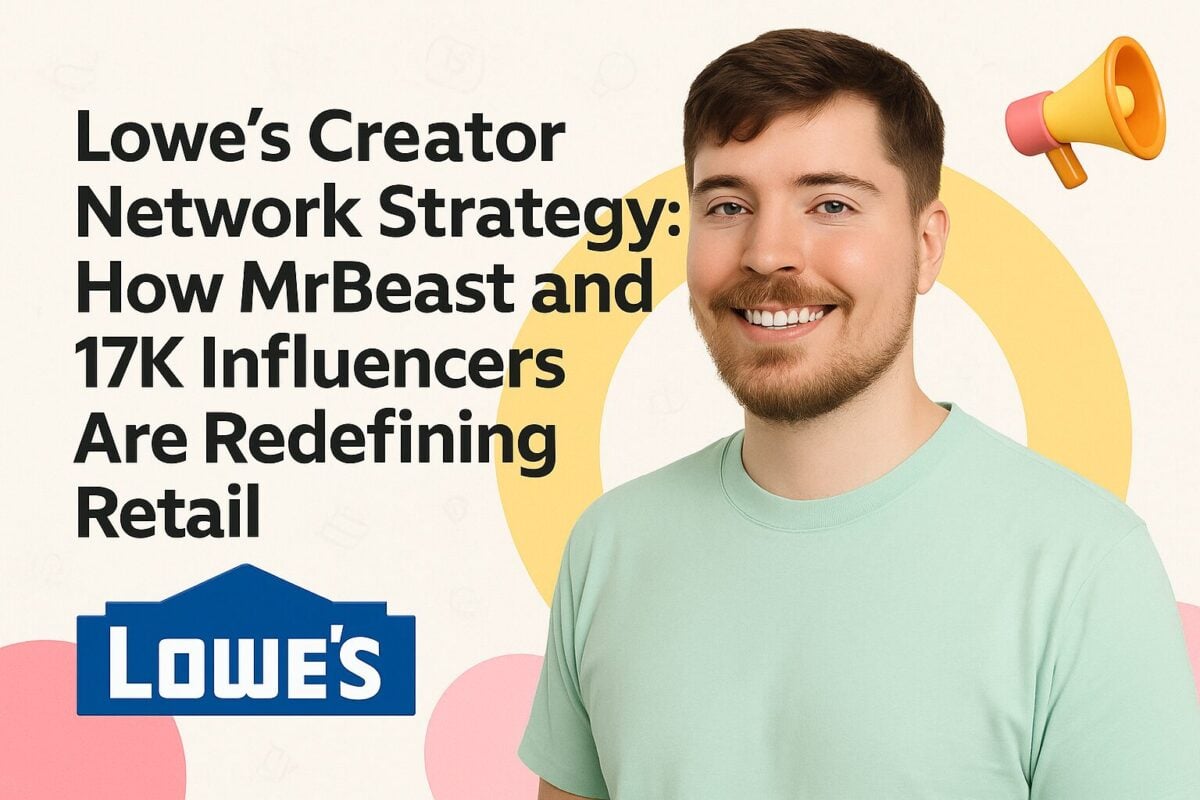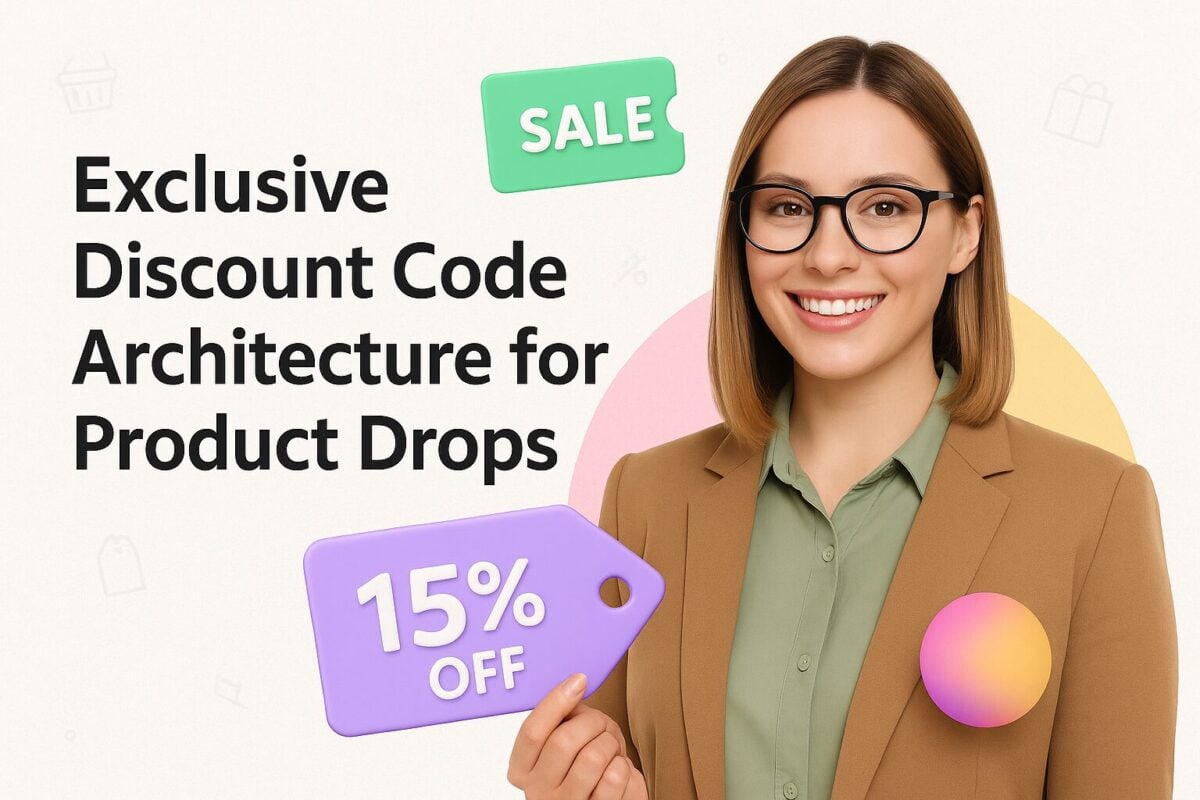Imagine the power in the palm of your hand—not just to shape purchasing decisions, but to shape public opinion, to influence elections, to impact policies.
In an age where a viral TikTok can reach more voters than a televised debate, could it be that social media influence—not campaign ads or rally speeches—ultimately decided the winner of this election?
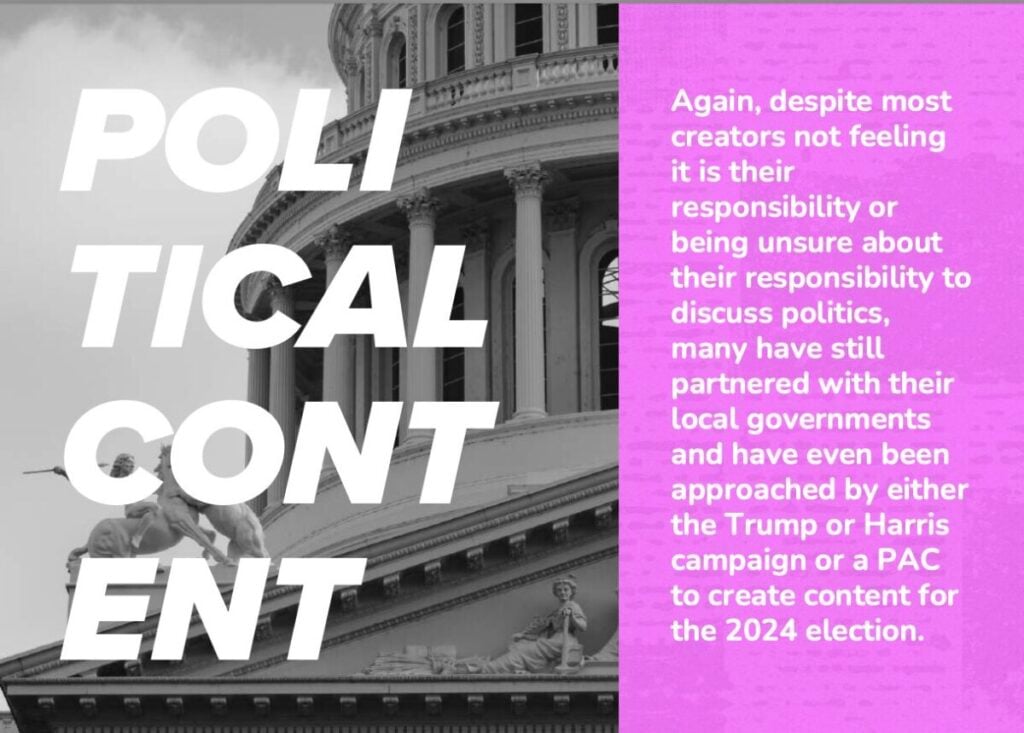
As we continue to dissect our findings together with Research Partner and Top Influencer Agency, NeoReach, from both content consumers and creators, a fascinating dynamic emerges, one where the lines between social, political, and marketing influence blur. The question isn’t simply whether influence works, but how deeply it reaches into our social fabric and political discourse.
And while some may say Donald Trump might struggle with a crossword and dismiss analytics as “fake news,” he sure gets the power of influencer marketing to trigger emotions, shift perspectives, and win over swing states through data-driven strategies. Case in point: he even made a campaign stop on the Joe Rogan podcast.
As for the ethical debate? His team seems to have understood that psychographics outperform demographics when it comes to driving informed marketing targeting and personalization.
Let’s set Cambridge Analytica aside for a moment—this time, he didn’t have Mark Zuckerberg on speed dial for data buys (... but perhaps he’s getting a little help from that other guy who just happens to run a certain social media platform).
Here are five main insights from the report marketers should learn:
- Influencers Are Key Drivers of Cultural and Political Influence
With 62.3% of influencers engaging in politically driven content, brands can leverage influencers not just for product promotion but as powerful agents of cultural and social impact. - Psychographics Outperform Demographics in Driving Engagement
Targeting based on psychological traits, as seen in 48.4% of audiences responding to socially responsible content, can lead to more resonant and lasting brand connections than traditional demographic targeting. - Authenticity is Non-Negotiable for Modern Consumers
With 40% of consumers prioritizing authenticity in endorsements, brands need to work with influencers who embody genuine values and avoid transactional partnerships that feel insincere. - Emotional Storytelling Enhances Engagement
Emotional content resonates strongly, with 40% of consumers feeling impactful emotions from political messages, highlighting an opportunity for brands to integrate deeper narratives into campaigns. - Social Media as the New Information Authority
With 34% of consumers relying on social media for political news, brands and influencers can capitalize on this shift by positioning themselves as credible, trusted sources in a decentralized news ecosystem.
- The Social Media Strategy That Changed Politics Forever
- The Consumers – Social Media’s Emerging Political Newsroom
- The Creators – From Content to Conscience
- Where Influence and Engagement Converge
- Social Media + Politics: The Real Power Players of 2024
- Influencers on Social Responsibility: When Engagement Becomes Activism
- Influencers and Political Partnerships: Navigating the Gray Area
- Platforms and the Shift Towards Real-Time Voting Engagement
- Data-Driven Strategies: The Lesson from Cambridge Analytica Lives On
- November Influencer & Consumer Insights: A Deep Dive into Data-Driven Trends
The Social Media Strategy That Changed Politics Forever
Back in 2016, Trump’s campaign didn’t just run ads; they transformed political strategy with a new blueprint for digital influence. Psychographic Targeting was their first weapon, using the OCEAN model to break down voters by personality traits—openness, conscientiousness, neuroticism. They crafted hyper-personalized messages that didn’t just reach people but connected with their deepest motivations, whether it was security, ambition, or stability.
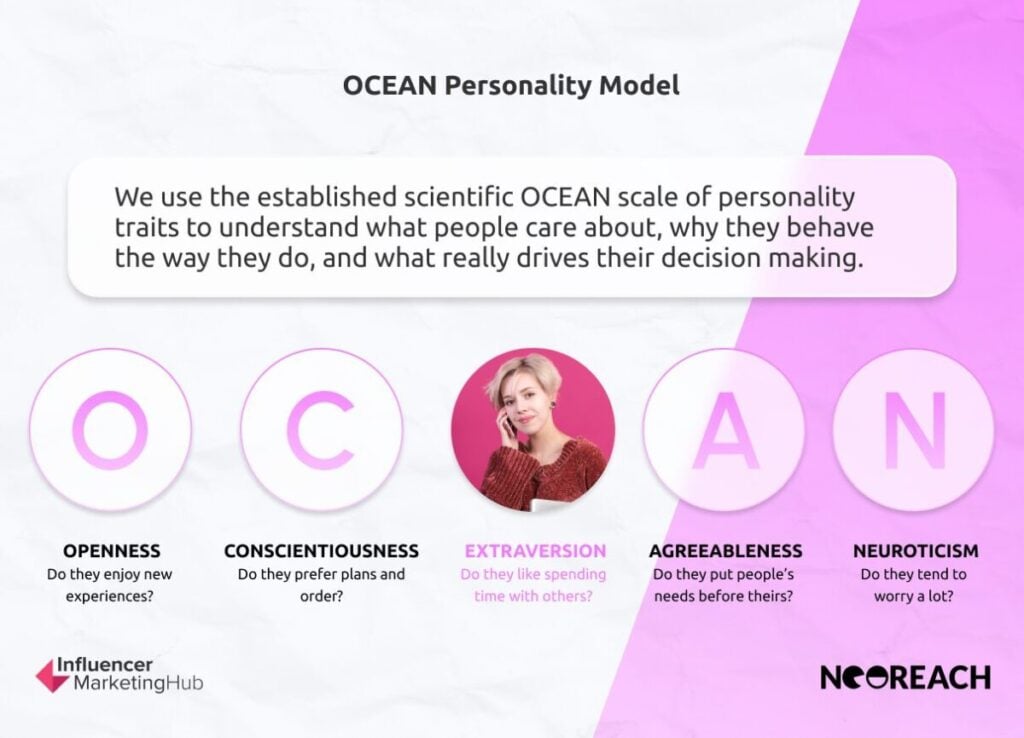
Then came Content Customization and Relentless A/B Testing. This wasn’t a scattershot approach; they tested everything to pinpoint emotional triggers that would resonate most—fear, pride, hope—adjusting in real-time for maximum impact. Each message felt personal, relevant, and emotionally charged.
Finally, Amplifying Reach through Data-Driven Strategy was the masterstroke. Leveraging Facebook’s data capabilities, they targeted and amplified content with surgical precision. Supporters became amplifiers, sharing the messages organically and creating a viral echo effect that went far beyond traditional paid ads. Again, ethics aside, the lesson for marketers is striking: when you understand your audience at a psychographic level, you’re not just communicating—you’re influencing beliefs and behaviors at scale.
The Consumers – Social Media’s Emerging Political Newsroom
Social Media as the New Political Front Page
Let’s start with a powerful takeaway: 34% of consumers report using social media as their primary source of political news. Traditional news isn’t obsolete, but it’s no longer the unchallenged gatekeeper. 27% still rely on TV and news websites, but the appeal of real-time, accessible updates on platforms like TikTok and Instagram is hard to ignore. Social media doesn’t just deliver news; it invites users into the narrative, where they engage, share, and react.
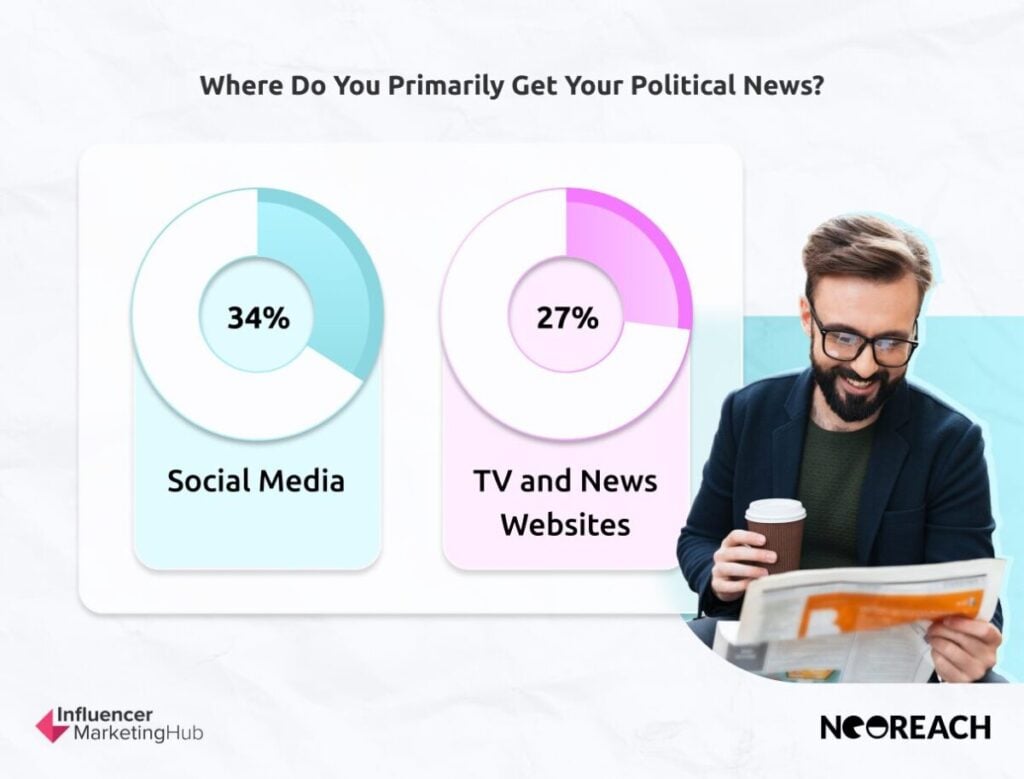
This shift sets the stage for social media influencers to act as information gatekeepers, positioning them as quasi-journalists in their own right. When traditional outlets sit alongside individual creators as sources of truth, we’re looking at an entirely new dynamic of information power. The rise of influencers as trusted educators challenges brands and campaigns to leverage their clout responsibly.
TikTok is the most politically active platform
According to NeoReach research, influencers overwhelmingly view TikTok as the most politically active platform, with 40.6% identifying it as the top choice for political engagement, followed closely by X at 35.8%. This insight is telling—it reflects the shift of political dialogue toward platforms where short-form, viral content dominates, resonating particularly with younger demographics.
TikTok’s prominence as the most politically active platform is indicative of a broader trend: audiences crave quick, visually engaging, and digestible content that fits seamlessly into their social media routines. The platform’s algorithm, designed to push real-time updates and emotionally charged content, has made it a natural fit for political discourse. X’s second-place ranking underscores its reputation as a hub for political activism and rapid news distribution, even as its user base shifts under new ownership.
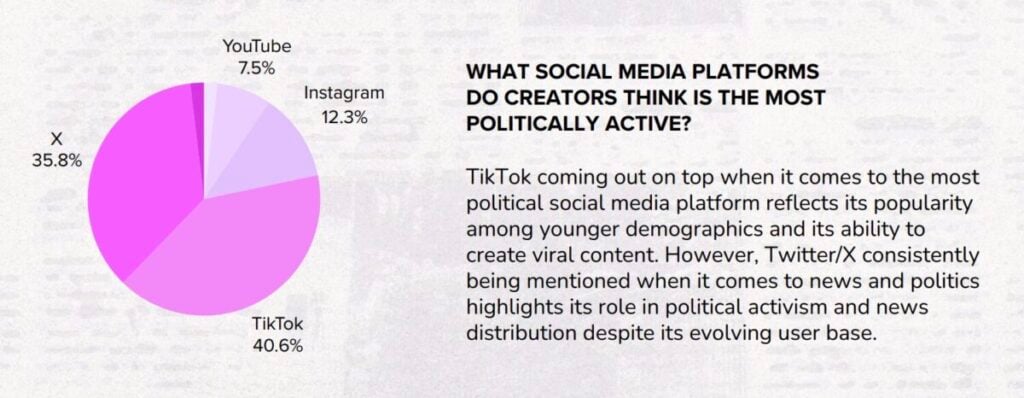
Admired Figures Fuel Political Exploration
Here’s where things get intriguing: 50% of content consumers are willing to explore political causes endorsed by influencers or public figures they admire, while only 23% claim they’re unaffected. For half of these respondents, endorsement from an admired figure isn’t just persuasive; it’s a call to action. But here’s the twist: 16% say it reinforces beliefs they already hold—classic confirmation bias at play.
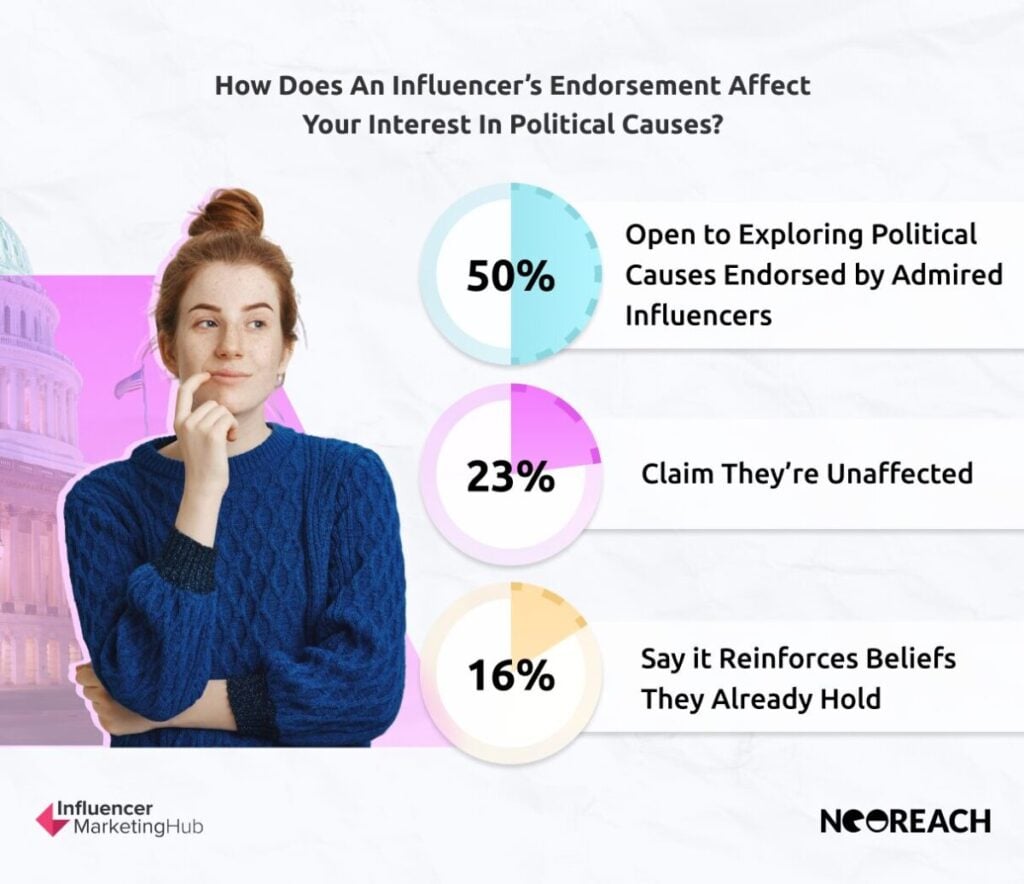
Among influencers, 62.3% shared politically charged content in 2024, with leading topics including reproductive rights, LGBTQ+ issues, and international conflicts like the war on Palestine. Influencers aren’t merely advocating; they’re shaping public discourse and mobilizing action. When half of the audience explores causes based on endorsements, we see influencers evolving from content creators to social advocates, becoming central to the socio-political landscape.
The Creators – From Content to Conscience
When Engagement Becomes Activism: The Rise of Socially Responsible Influencers
In 2024, creators took on a new role: advocates for social causes. With 62.3% sharing politically charged content, it’s clear that the issues of the day—from LGBTQ+ rights to global conflicts—are resonating on a deeply personal level with influencers. And they’re not stopping at awareness; 48.4% of audiences are more likely to consider causes endorsed by influencers, suggesting a transformation of influence into tangible action.
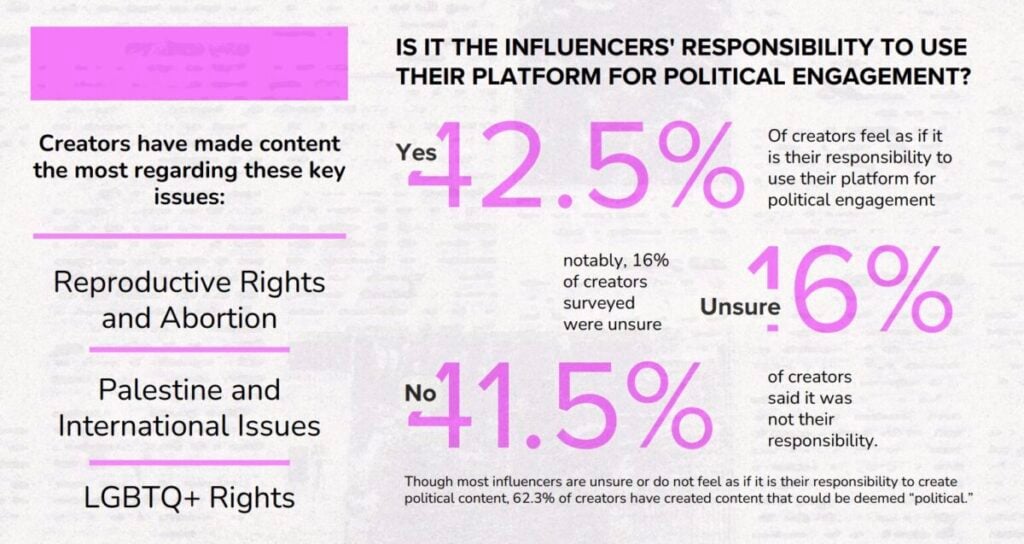
As influencers shift towards values-driven content, consumers are increasingly receptive to politically motivated endorsements. This harmony between influencer advocacy and consumer exploration highlights a mutual desire for authenticity in political discourse. Influencers aren’t merely selling products—they’re promoting change, with their audience ready to follow.
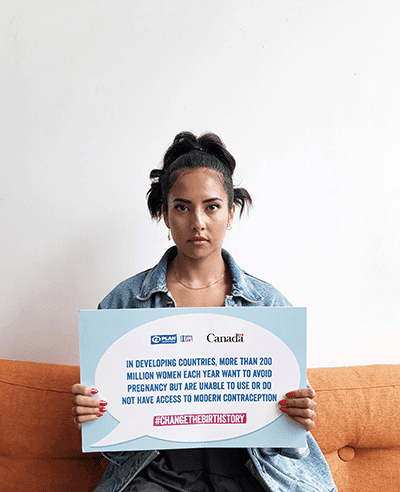
Platform Power: Real-Time Voting Engagement
2024 saw social media platforms like TikTok and Snapchat actively engaging in the electoral process. TikTok’s election center, Snapchat’s partnership with Vote.org, and Meta’s election tools each played a role in voter mobilization. These aren’t simply corporate features—they’re tools for civic engagement. The platforms have evolved from spaces of social interaction to catalysts for democratic participation.
34% of consumers rely on social media for political news, and platforms are responding by amplifying access to election resources. For brands, this marks an essential shift. The platforms’ direct involvement in civic engagement signals to brands the value of prioritizing social responsibility and community-focused content. Authenticity, now more than ever, is tied to a brand’s commitment to the issues that matter to its audience.
Where Influence and Engagement Converge
1. Authenticity: The Core of Political Endorsements
One major takeaway? 40% of consumers believe that authenticity is critical in political endorsements. Meanwhile, 42.5% of influencers feel a responsibility to encourage political engagement, but with a caveat: many are hesitant to promote paid political content, fearing it might compromise their authenticity.
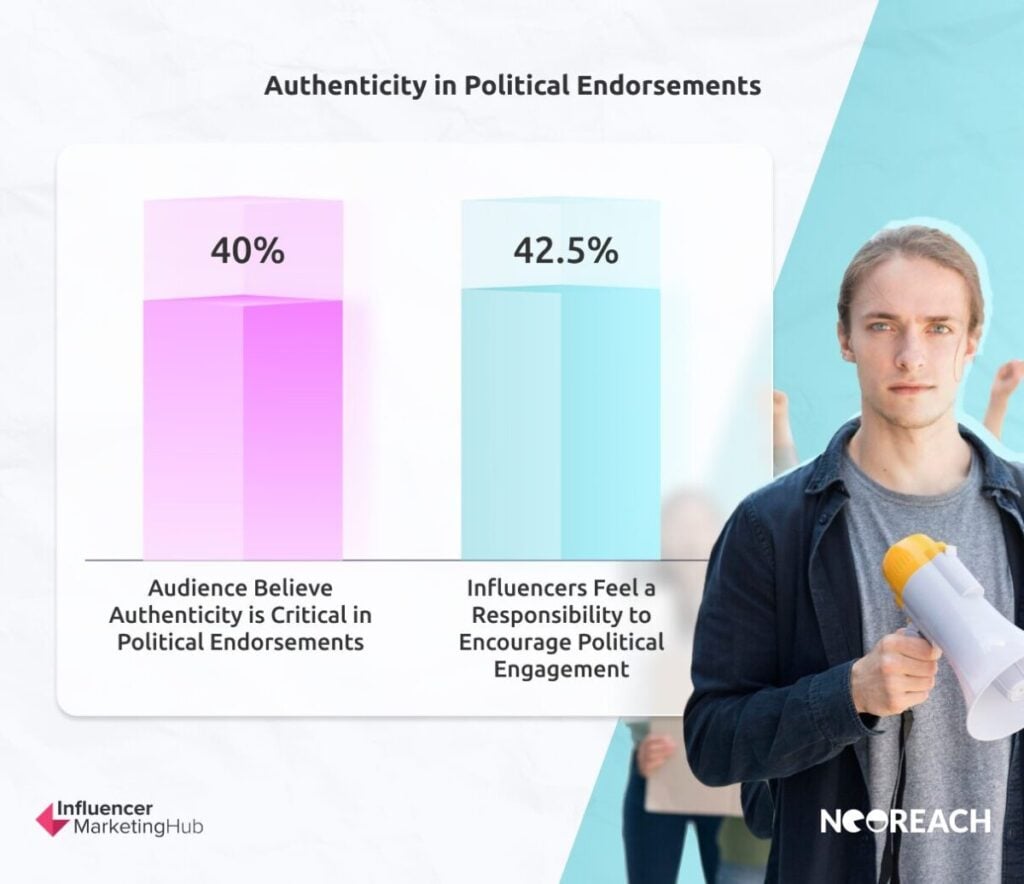
There’s a clear connection between consumer demand for authenticity and influencer hesitancy to engage in overtly paid political content. Consumers want real, unfiltered endorsements, and influencers are willing—but cautious—to deliver. For brands, this implies that working with influencers who genuinely align with the cause is far more effective than transactional partnerships. Authenticity isn’t just a trend; it’s the linchpin of modern influence.
2. The Role of Personal Stories in Political Engagement
Consumers gravitate toward content that feels genuine and relatable. 29% of consumers are most engaged by personal stories related to political issues, whereas only 16% find traditional endorsements compelling. Influencers, too, are responding to this preference by sharing content that delves into their personal values and struggles rather than strictly endorsing candidates or parties.
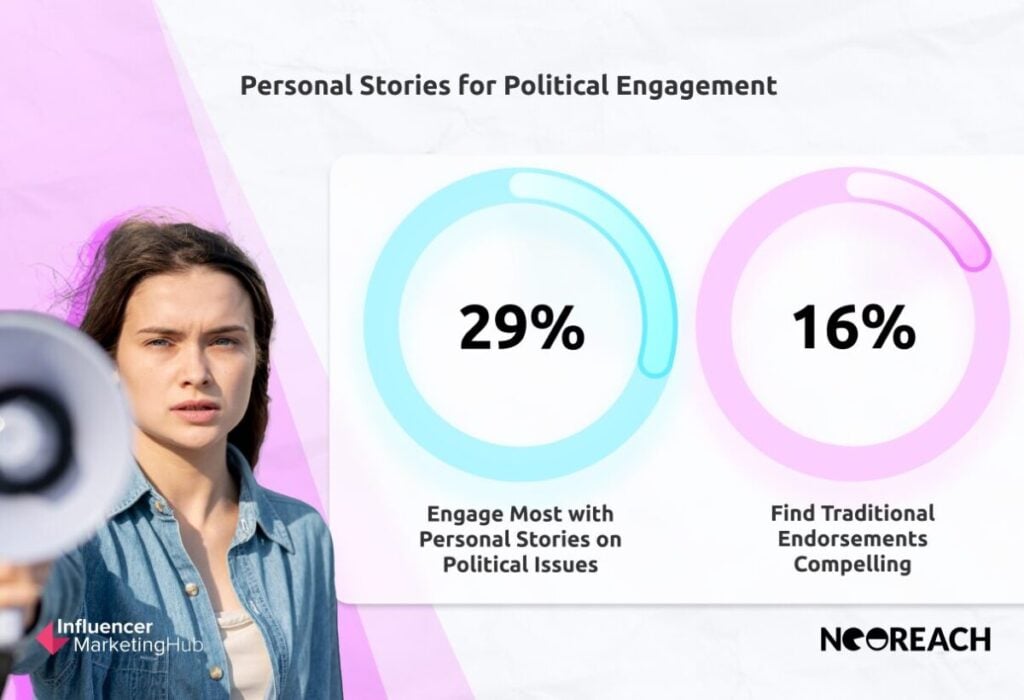
The convergence of this preference shows us a pivotal shift: audiences are not seeking a hard sell; they want relatability. Influencers who share personal narratives, struggles, and perspectives create a resonance that traditional endorsements lack. For brands, this means that campaigns centering on real-life stories, rather than corporate messaging, stand to capture a more engaged and loyal audience.
3. The Emotional Pull of Political Content
Political content on social media has a powerful emotional impact. 40% of consumers report frequent emotional reactions to political content, ranging from anger to hope. This is a space that creators understand well—62.3% of influencers address emotionally charged issues, harnessing the power of narrative to connect with audiences on deeper, more visceral levels.
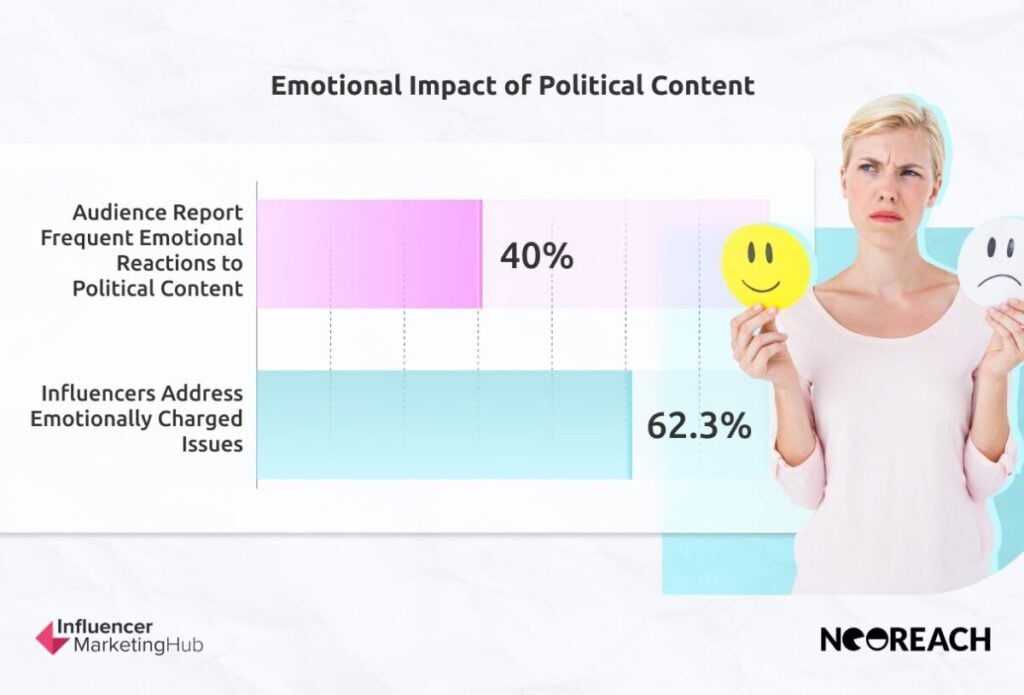
Emotional engagement is no longer a bonus—it’s a strategic necessity. For brands looking to drive meaningful connections, campaigns need to address issues that resonate on an emotional level. It’s not about stoking outrage but fostering genuine concern, empathy, and hope. Influencers have mastered this emotional connection; now, it’s time for brands to follow suit.
4. Social Media as a News Source: Trust vs. Skepticism
A significant 34% of consumers turn to social media for political news, outpacing traditional channels. Yet, with this shift comes a heightened responsibility for influencers and platforms to ensure credible and balanced information. Social networks have made strides in this area, adding features like “report fake news” options and, in some cases, providing additional context on trending topics—as seen with X’s fact-checking labels.
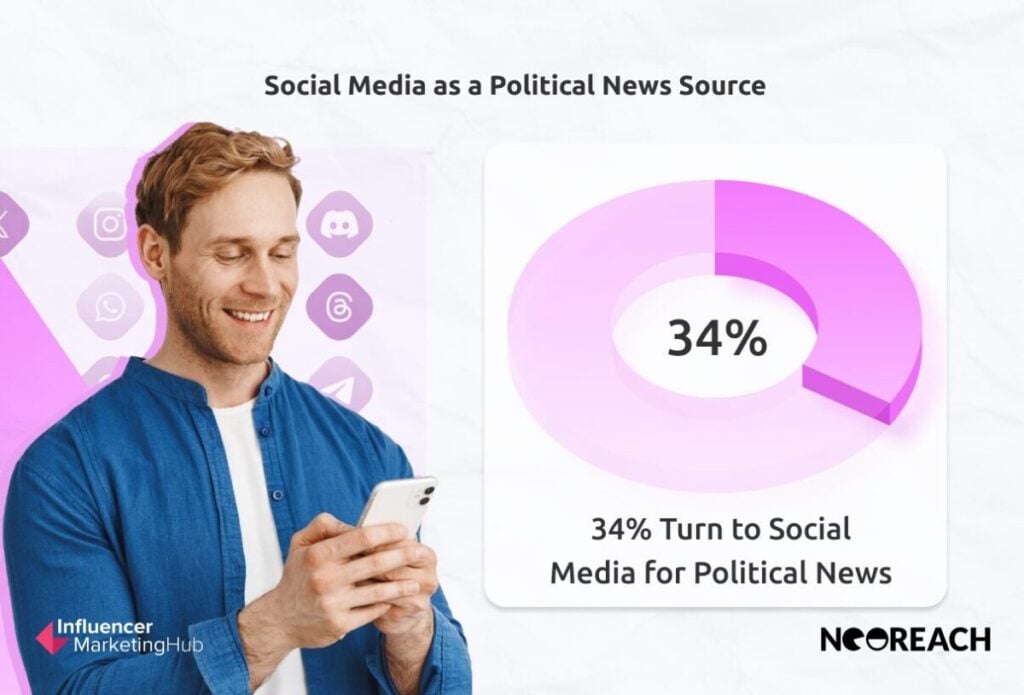
For brands, this evolution from passive to active information consumption means campaigns can no longer skate by on slogans alone. Content has to be nuanced, credible, and backed by real-world relevance. The trust audiences place in social media figures is a double-edged sword; with influence comes responsibility, and brands partnering with influencers must prioritize accuracy and transparency.
5. Platform-Driven Political Mobilization: A Blueprint for Brand Engagement
The proactive engagement of social platforms in the 2024 election—voter registration tools, election centers, and misinformation countermeasures—reflects a broader trend towards actionable digital citizenship. Brands and influencers can take cues here, leveraging these tools to drive not just awareness but action, encouraging audiences to participate in broader social causes.
The success of platforms in voter mobilization offers brands a clear roadmap: integrate actionable, community-driven elements into your campaigns. It’s about moving from awareness to engagement, turning followers into active participants in causes. Brands that champion not just the message but the action behind it will be the ones that truly stand out.
Social Media + Politics: The Real Power Players of 2024
Imagine this: Presidential campaigns no longer rely on traditional mass media; instead, they’re engaging on TikTok, Instagram, and even Substack, speaking directly to their base. According to our study with NeoReach, social media became ground zero for political discourse in 2024, dominating how Americans engaged with the election. TikTok alone saw over 100 million mentions related to the election in the first half of the year.
The Why Behind This Social Surge: As platforms evolve, they offer new ways for users to experience news through short, interactive formats. TikTok’s algorithm helped push real-time updates and emotional narratives straight into people’s feeds, creating an environment where political engagement felt almost inevitable.
For political campaigns, this is more than just marketing—it’s a strategy rooted in engagement at scale. When the Democratic and Republican conventions hosted a combined 300 influencers, it wasn’t just about reach; it was about relevance. These events validated the Creator Economy as a powerhouse for shaping public opinion. Social media isn’t just a tool anymore; it’s a political necessity.
Influencers on Social Responsibility: When Engagement Becomes Activism
Here’s a hot topic: Influencers today are tackling more than brand sponsorships—they’re amplifying social issues. This year, 62.3% of creators shared politically-driven content, with topics like reproductive rights, LGBTQ+ issues, and international conflicts, especially the situation in Palestine, taking center stage. This isn’t just a coincidence; it’s a reflection of the world we’re living in, where global crises are unavoidable and influencers feel a moral duty to engage.
And they’re not alone. 48.4% of their audiences are more likely to consider a cause endorsed by someone they admire, signaling a significant shift in how influence translates into real-world action. The impact? A new era of “cause-based influence,” where audiences expect and engage with content that matters. This makes the “influencer” title almost too limiting—creators are emerging as social advocates, adding layers of depth to their online personas and connecting with followers on values as much as products.
Influencers and Political Partnerships: Navigating the Gray Area
Now, let’s talk about one of the biggest changes in campaign strategy: partnerships with influencers. In 2024, 22.6% of creators were approached by political campaigns or PACs to promote voting and candidate support. While this sounds effective, the ethical lines are blurry.
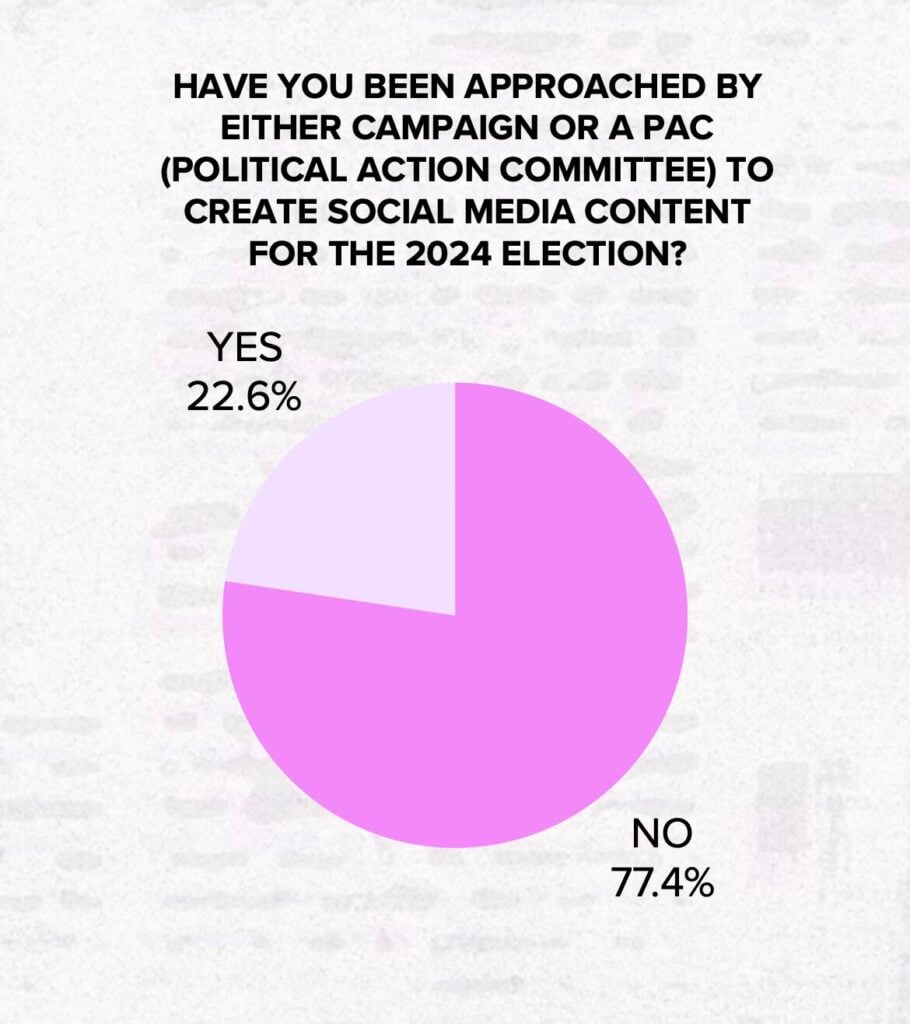
On one hand, 42.5% of creators feel it’s their responsibility to promote political engagement. On the other, a growing number are uneasy about using their platforms for paid political content, fearing it may erode their authenticity. This debate has only intensified as political entities recognize influencers as key vehicles for outreach, particularly among young voters.
The takeaway? Authenticity remains the currency of influence. Influencers are willing to align with political causes, but there’s a line—and stepping over it could risk their hard-earned credibility. For brands and campaigns alike, this underlines a critical truth: influencer partnerships in the political sphere must be approached with care and transparency.
Platforms and the Shift Towards Real-Time Voting Engagement
Let’s look at the platforms themselves. With a renewed push towards political engagement, platforms like TikTok and Instagram have adapted, integrating voting registration resources directly into their interfaces. In 2024, TikTok launched a comprehensive election center that provided users with everything from registration help to polling station information.
Compared to 2020, platforms have doubled down on voting-related features:
- Snapchat partnered with Vote.org to make in-app voter registration seamless.
- Meta launched its own election center, where users could access information for launching campaigns, engaging voters, and promoting voter education.
- Twitter’s AI Chatbot was even modified to direct users to reliable voting information after it was found spreading misinformation.
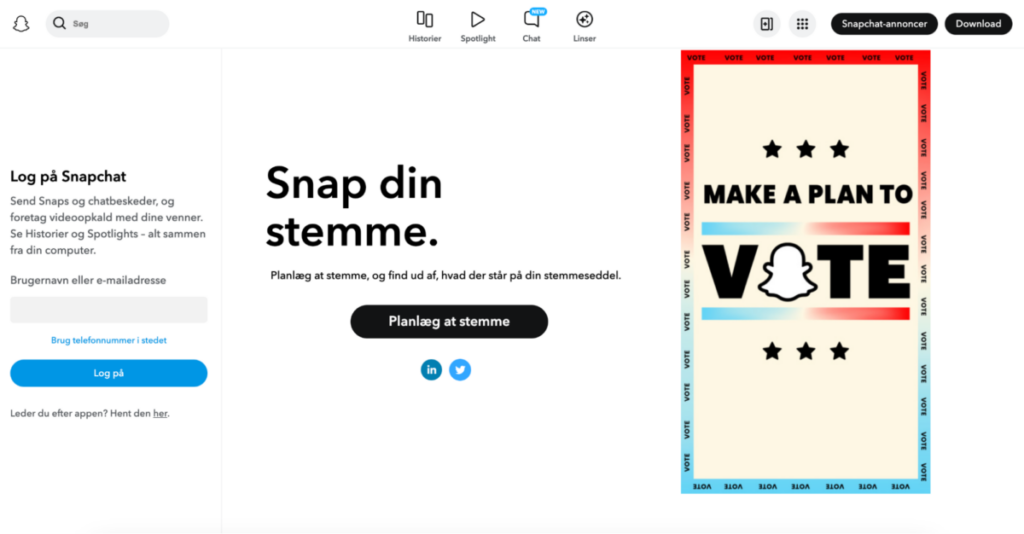
This evolution shows us a future where social media isn’t just about visibility but about action. These platforms are pushing past the boundaries of content-sharing to drive meaningful, real-world engagement. For brands, this is a lesson in taking social responsibility to new heights—engagement features like polls, registration reminders, and real-time news integrations are now staples of effective digital strategy.
Data-Driven Strategies: The Lesson from Cambridge Analytica Lives On
It wouldn’t be a modern marketing report without talking about data. And here’s where it gets spicy: if there’s one thing the Cambridge Analytica controversy taught us, it’s that data, when used strategically, has unprecedented power.
Today’s campaigns are more data-driven than ever, with 54.8% of marketers viewing AI favorably for enhancing campaign efficiency. But here’s the kicker—data is only as effective as the strategy behind it. Cambridge Analytica’s psychographic segmentation wasn’t just about micro-targeting; it was about creating a connection that felt personal and authentic.
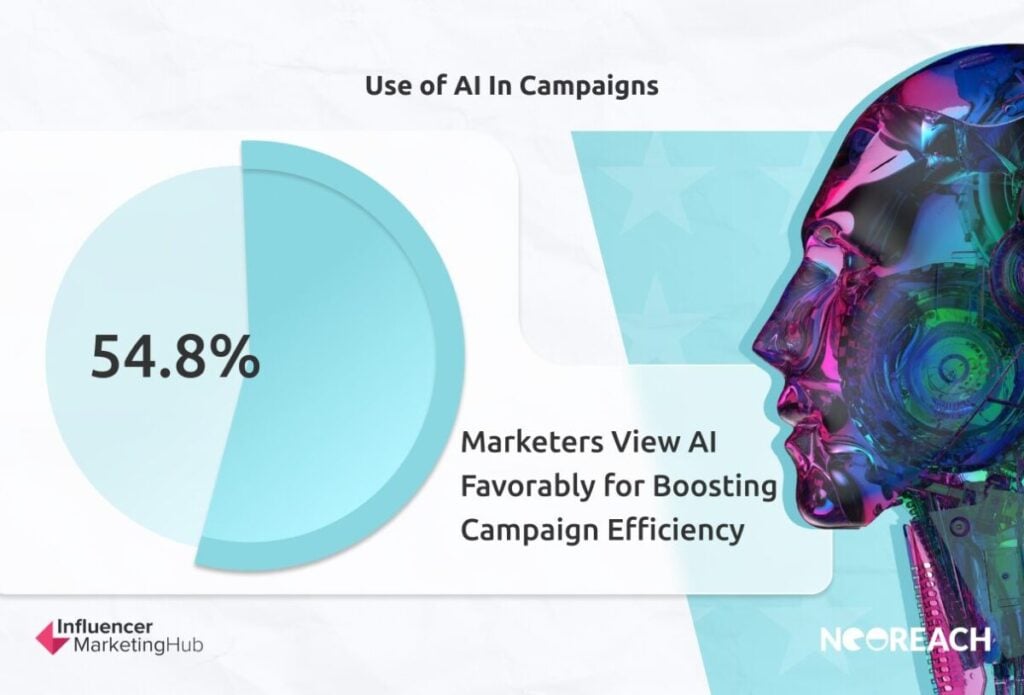
Now, brands are beginning to leverage AI to a similar effect. By analyzing sentiment and engagement metrics, they can refine influencer campaigns for a more tailored experience. This isn’t about manipulating audiences but about understanding them on a deeper level—what makes them tick, what they value, and how they’re likely to engage. And the results are telling: data-backed, human-centered campaigns are far outperforming traditional models, making it clear that influence is as much about connection as it is about numbers.
The final takeaway? Brands and campaigns that fail to integrate data and AI-driven insights will fall behind. But those who marry data precision with authentic storytelling are poised to lead the charge into the future.
November Influencer & Consumer Insights: A Deep Dive into Data-Driven Trends
(First-Party Data Analysis by Influencer Marketing Hub and NeoReach Surveys)
As we dive into the November 2024 insights from both Influencer Marketing Hub (IMH), capturing the perspectives of 100 content consumers, and NeoReach, focusing on influencers and creators, a vivid picture emerges of how social media has reshaped political engagement. Through examining each dataset, from the IMH findings on content consumer behavior to NeoReach’s influencer-focused insights, we can draw provocative conclusions about the shifting power dynamics in digital influence.
Influencer Marketing Hub Findings: Content Consumer Perspectives
Social Media as the Primary Source for Political News
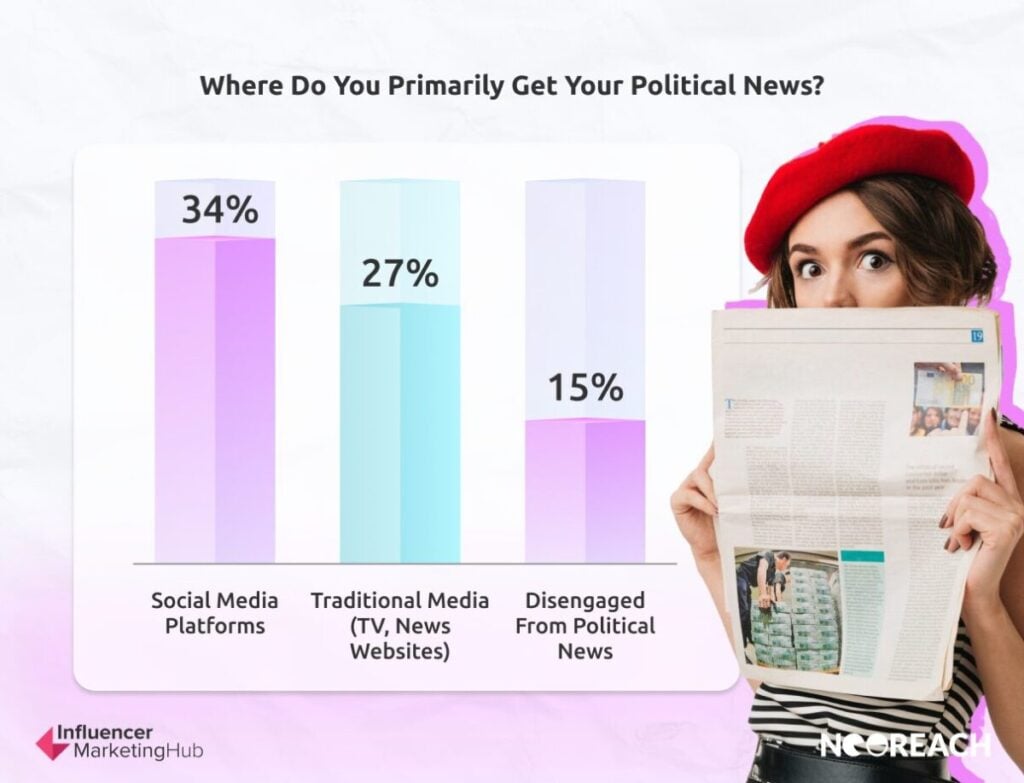
- 34% of consumers now primarily rely on social media platforms like Facebook, Instagram, and X for their political news, placing it above traditional sources.
- Traditional news websites and TV networks account for 27% of consumers' preferred sources, while 15% remain disengaged from political news.
Implications:
This shift illustrates social media’s growing dominance as a trusted news source, underscoring an opportunity for brands and influencers to position themselves as reliable informants in an increasingly personalized information ecosystem.
Influence of Admired Figures on Political Opinions
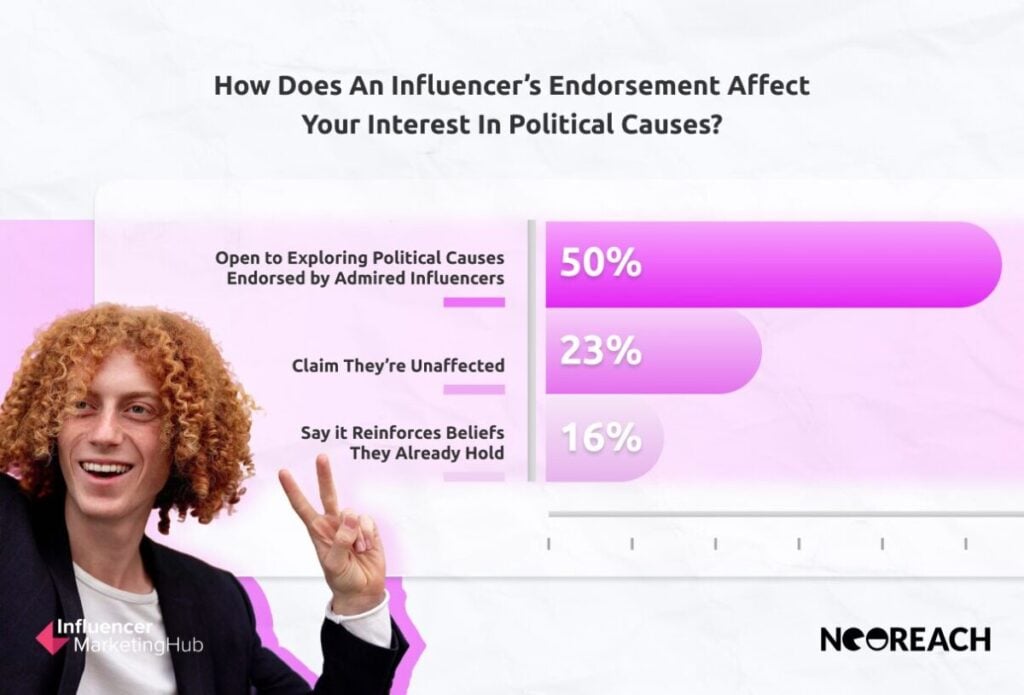
- 50% of respondents are more inclined to explore a political cause if it is endorsed by a public figure or influencer they admire.
- 23% say such endorsements don’t affect their opinions, while 16% note it reinforces their existing beliefs.
Implications:
Admired influencers wield significant sway, often prompting audiences to reconsider political issues. This highlights the critical role of selecting authentic, value-aligned influencers in driving political engagement.
Emotional Responses to Political Content on Social Media
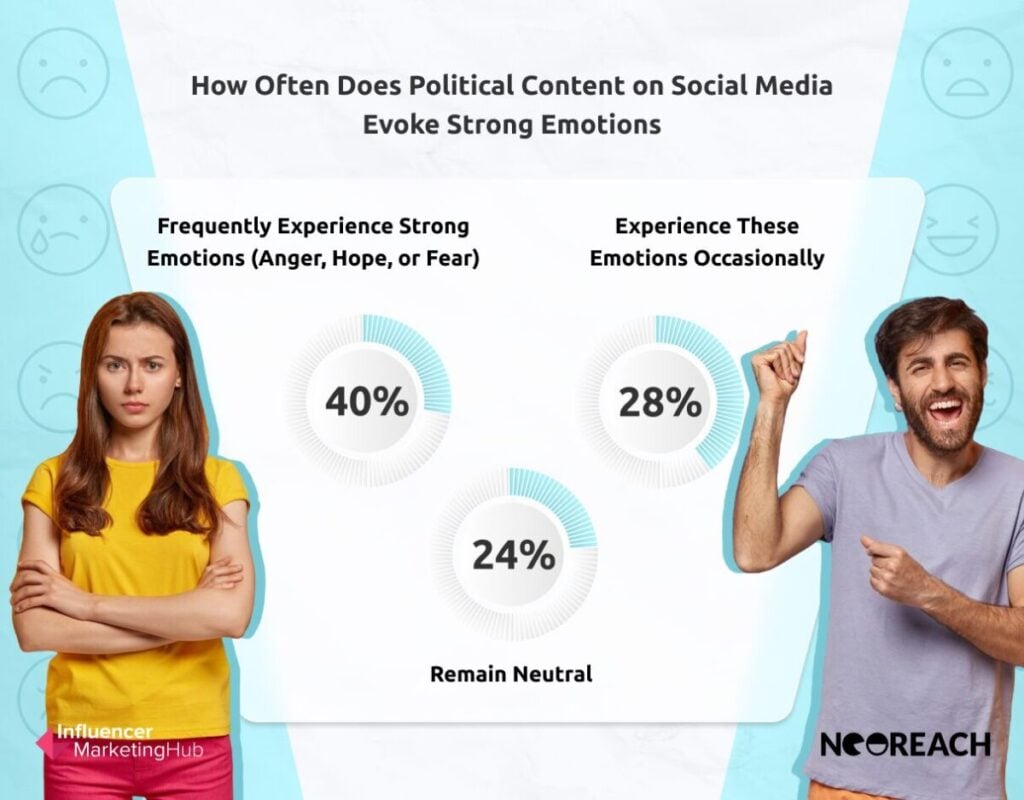
- 40% of respondents frequently experience strong emotions such as anger, hope, or fear when they see political content shared by people they follow.
- 28% experience these emotions occasionally, and 24% remain neutral.
Implications:
Emotional engagement with political content underscores the effectiveness of emotionally resonant messaging. Influencers and brands that incorporate storytelling that taps into these emotions are more likely to forge stronger connections with their audience.
Key Influences in Political Decision-Making
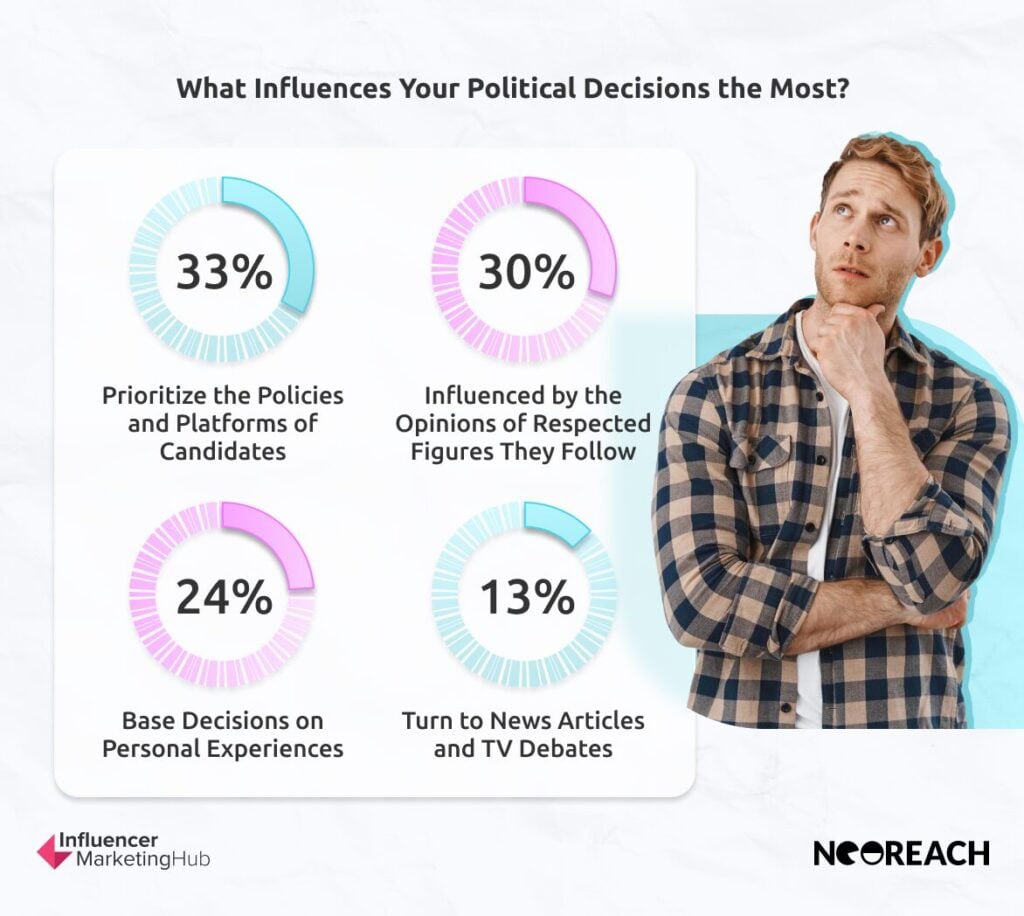
- 33% of respondents prioritize the policies and platforms of candidates when deciding whom to support, while 30% are influenced by the opinions of respected figures they follow.
- 24% base decisions on personal experiences, while 13% turn to news articles and TV debates.
Implications:
The combination of personal conviction and social validation reflects the nuanced nature of political decision-making. Brands interested in addressing political or social issues can benefit from pairing well-researched content with endorsements from authoritative voices.
Social Conformity and the Desire for Like-Minded Communities
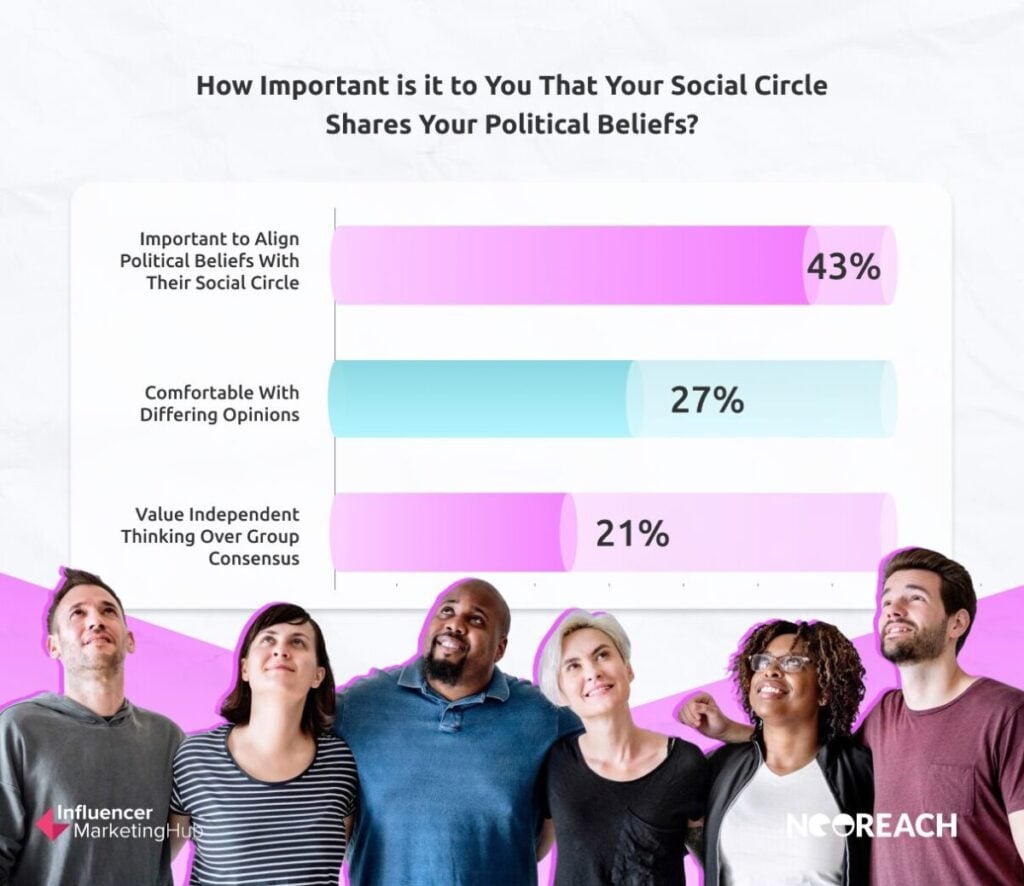
- 43% of respondents consider it very important that their political beliefs align with those in their social circles.
- 27% are comfortable with differing opinions, and 21% value independent thinking over group consensus.
Implications:
Social conformity remains a strong driver of political alignment. Campaigns that foster community and unity in beliefs—while respecting individual perspectives—could strengthen audience loyalty and engagement.
Engagement with Political Content on Social Media
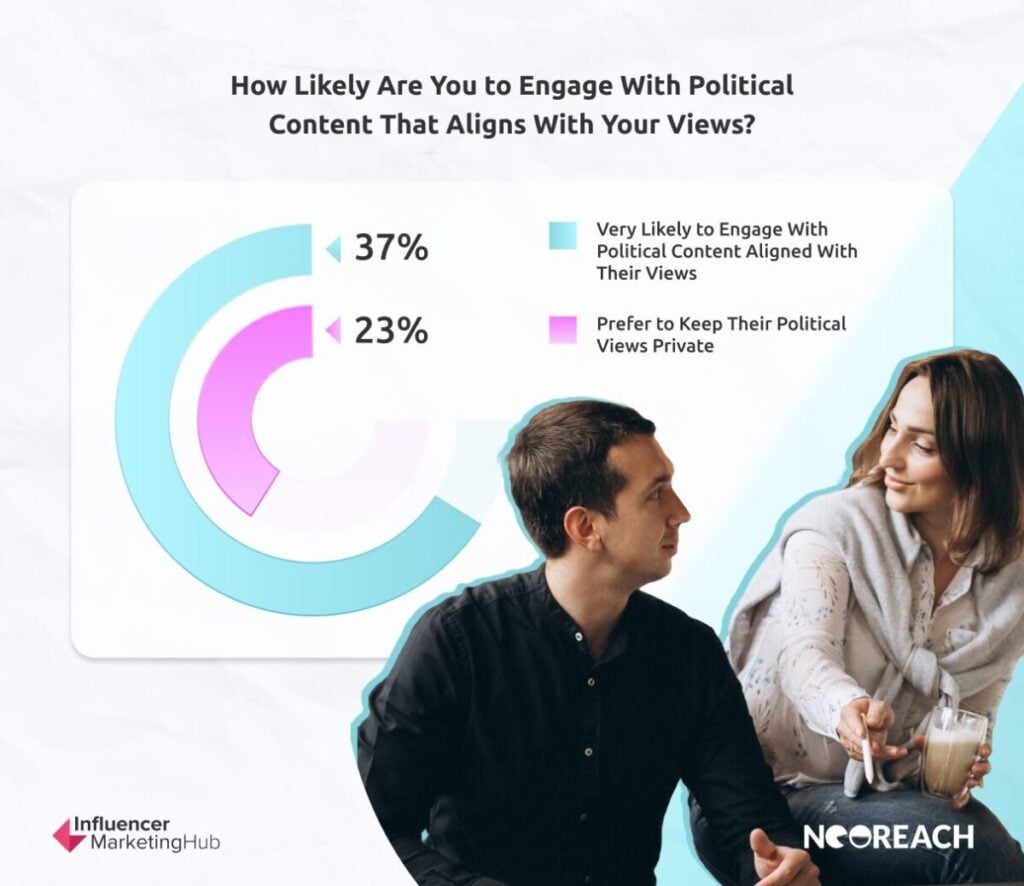
- 37% of respondents are very likely to engage with political content aligned with their views, while 23% prefer to keep their political views private.
Implications:
The divide between public and private political engagement is vital for brands aiming to maximize audience reach, suggesting a need for respectful and nuanced discourse in content strategies.
Reaction to Divergent Political Opinions
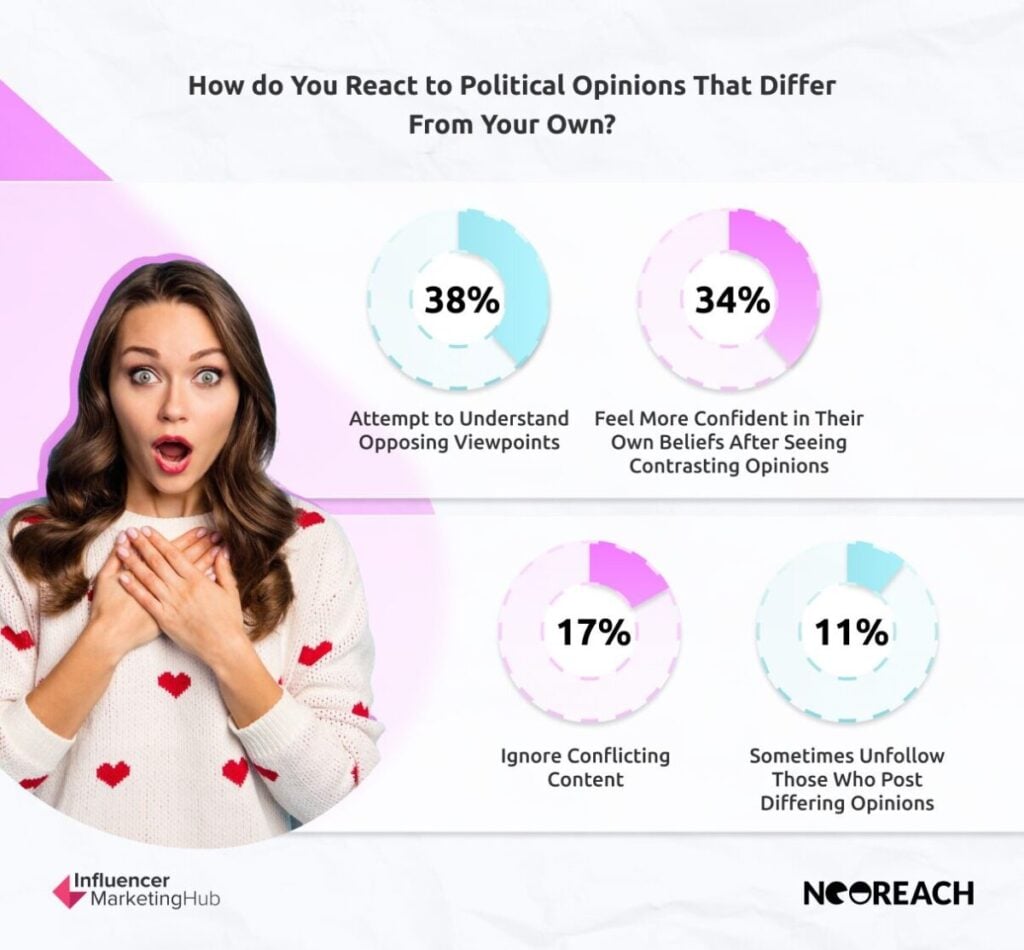
- 38% try to understand opposing viewpoints, while 34% report feeling more confident in their own beliefs after seeing contrasting opinions.
- 17% ignore conflicting content, and 11% sometimes unfollow those who post differing opinions.
Implications:
This finding points to an evolving digital landscape that values open-mindedness and tolerance, presenting an opportunity for brands to promote dialogue and understanding within their communities.
Types of Political Content that Capture Attention
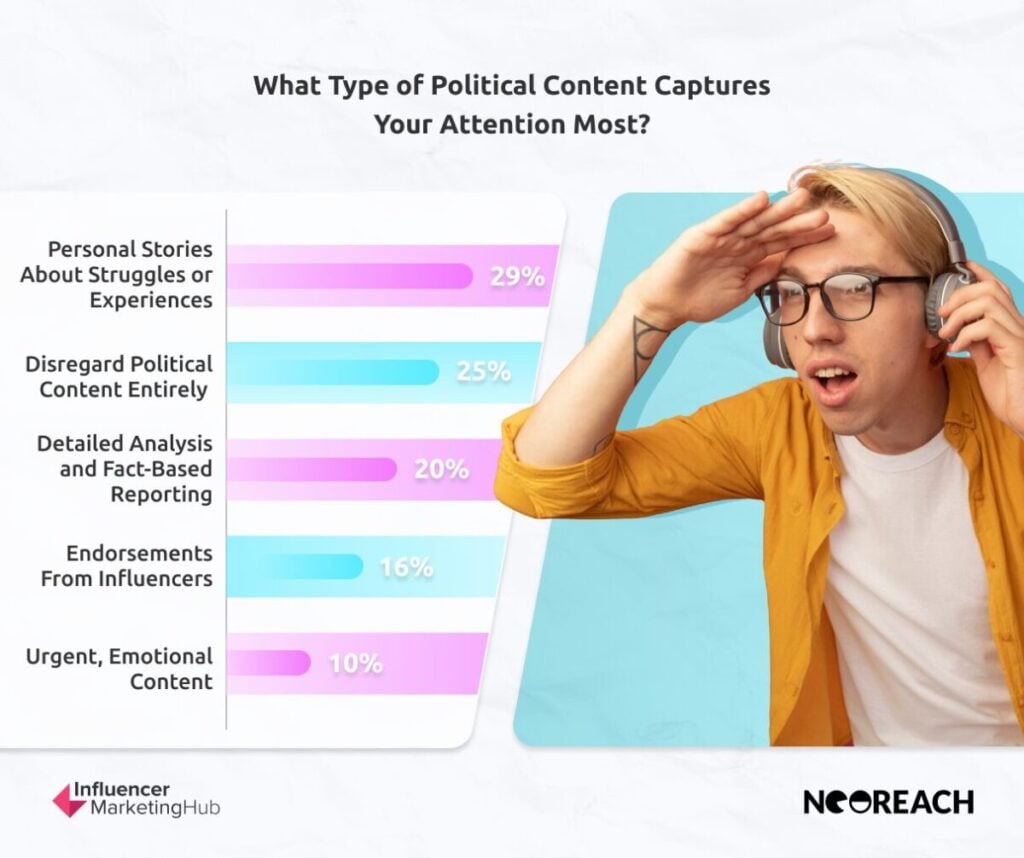
- 29% are most drawn to personal stories about struggles or experiences.
- 25% disregard political content entirely, while 20% favor detailed analysis and fact-based reporting.
- 16% are swayed by endorsements from influencers, and 10% respond to urgent, emotional content.
Implications:
The preference for authentic storytelling over straightforward endorsements suggests that influencers can achieve greater impact through real-life narratives, resonating with audiences on a deeper level.
Impact of Personal Stories on Political Views
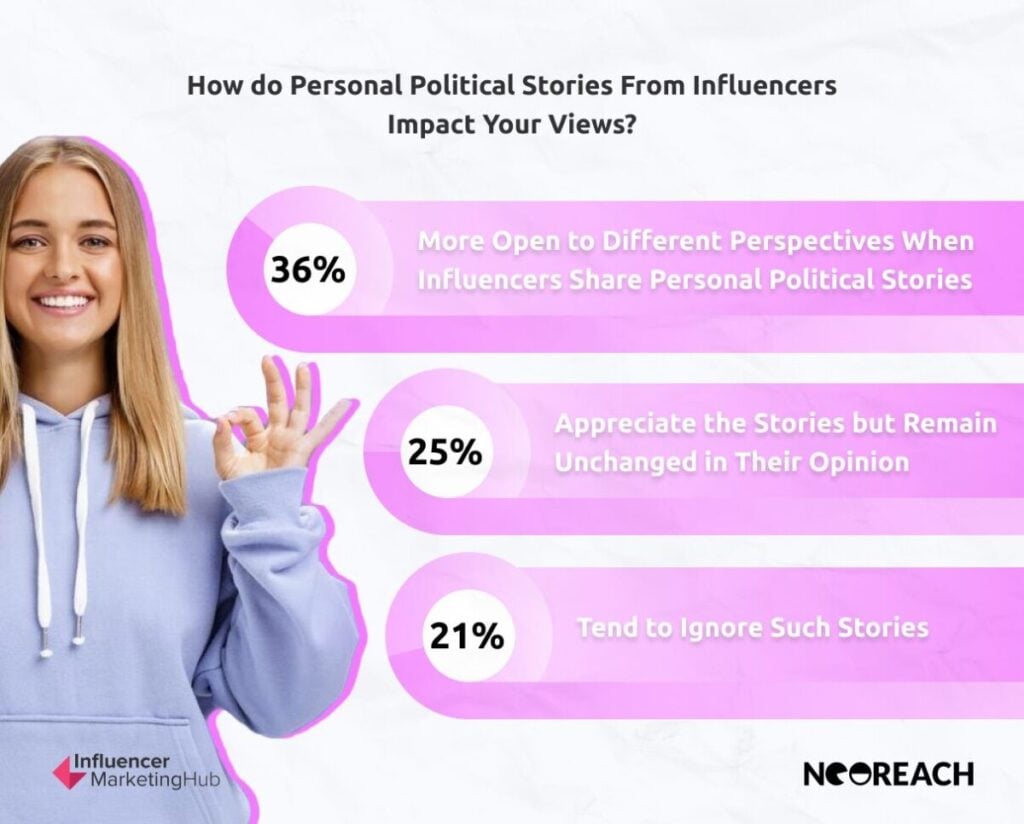
- 36% are more open to different perspectives when influencers share personal political stories.
- 25% appreciate the stories but remain unchanged in their opinion, while 21% tend to ignore such stories.
Implications:
Personal stories can open doors for dialogue and empathy, positioning influencers as relatable figures capable of fostering thoughtful, value-driven engagement on important issues.
NeoReach Findings: Influencer and Creator Perspectives
TikTok's Role as a Political Platform
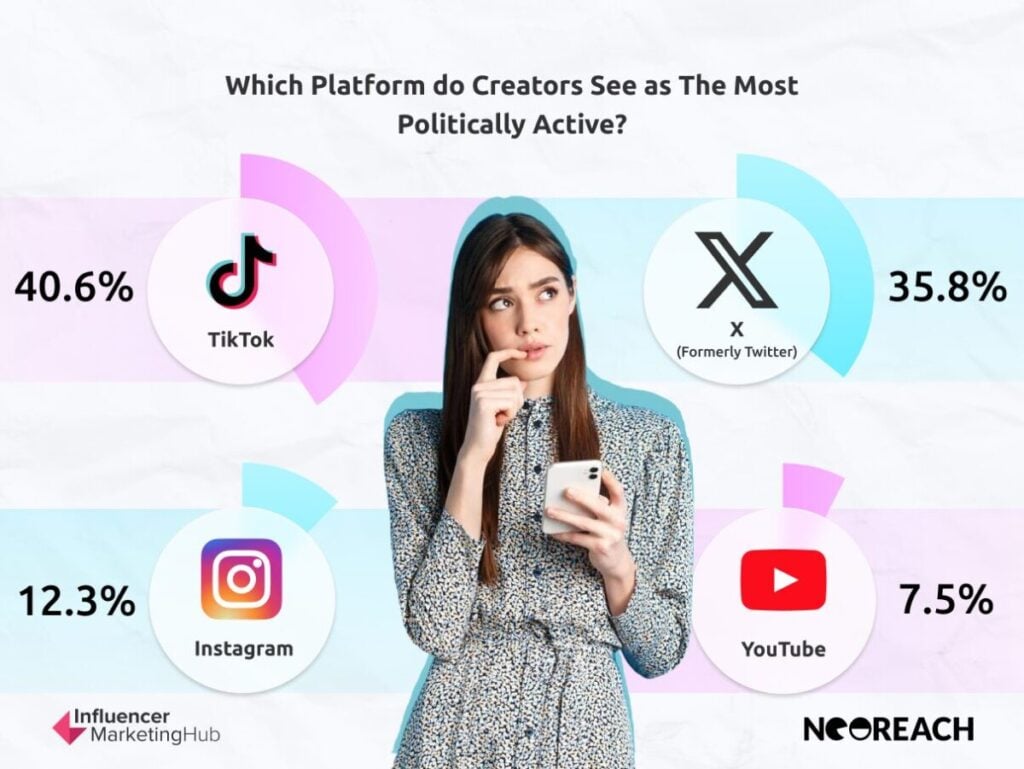
- 40.6% of creators view TikTok as the most politically active platform, followed by 35.8% who identify X (formerly Twitter) as significant.
- Instagram ranks lower at 12.3%, with YouTube at 7.5%.
Implications:
TikTok’s leading role in political discourse highlights its effectiveness for engaging younger, politically active audiences. Brands and campaigns may benefit from emphasizing TikTok as a focal point for political messaging.
Creator-Driven Political Content and Activism
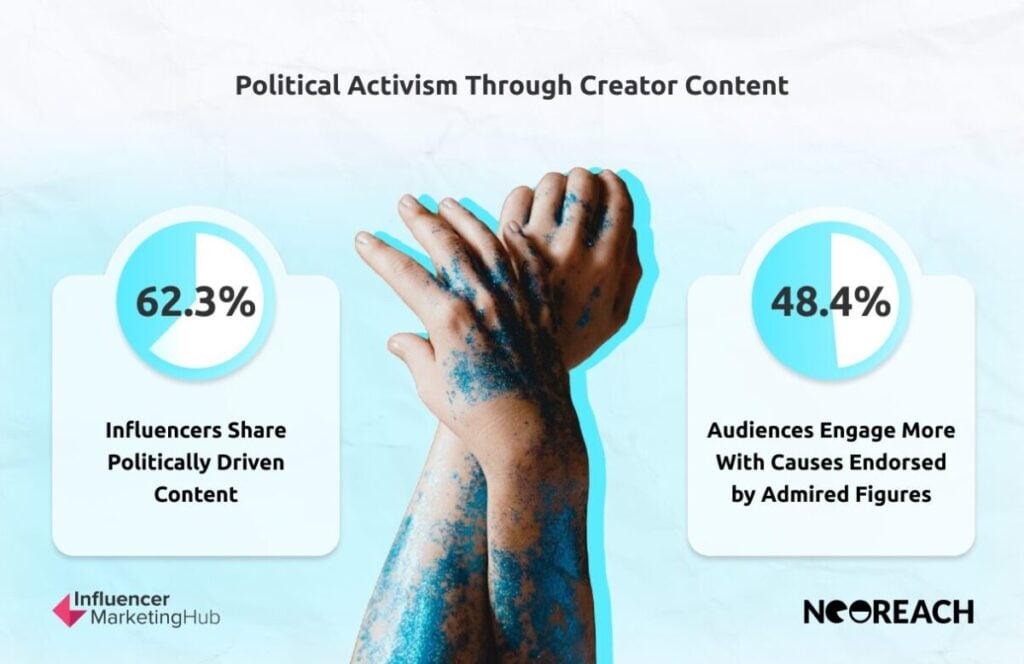
- 62.3% of influencers share politically driven content, with popular topics including reproductive rights, LGBTQ+ issues, and the Palestine conflict.
- 48.4% of their audiences are more likely to engage with a cause if endorsed by someone they admire.
Implications:
Creators are evolving from brand promoters to social advocates, marking a shift towards “cause-based influence.” This trend suggests audiences expect influencers to voice opinions on critical social issues.
Ethics and Political Partnerships
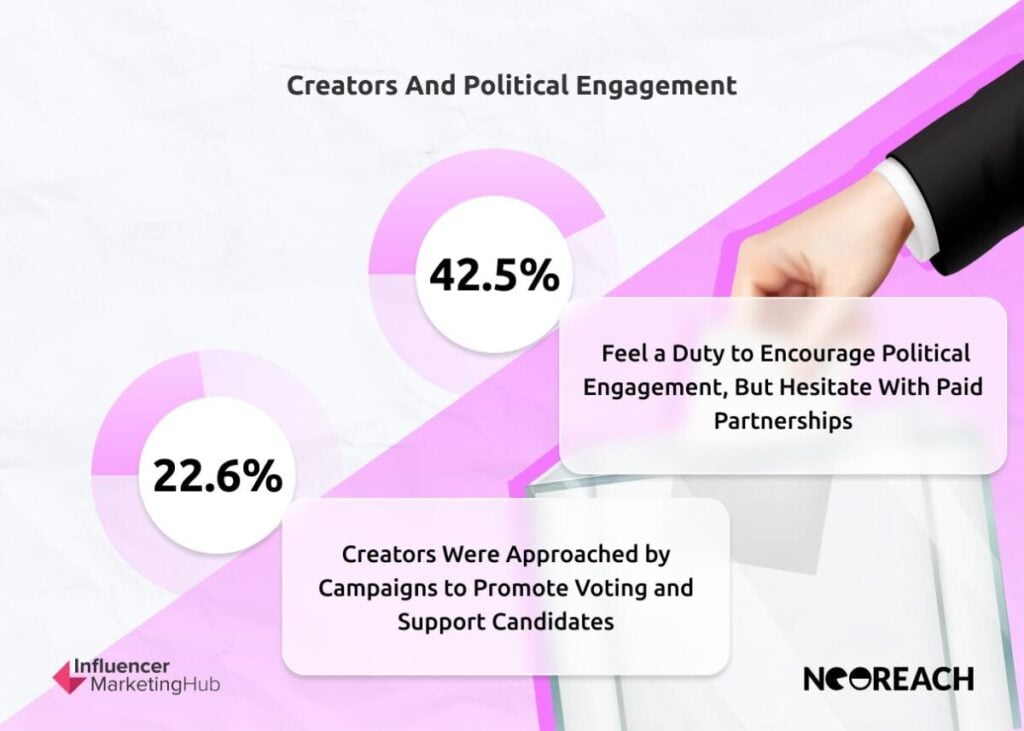
- 22.6% of creators have been approached by political campaigns or PACs to promote voting and support candidates.
- 42.5% feel it’s their responsibility to promote political engagement, although some hesitate to accept paid political partnerships.
Implications:
Political endorsements from influencers are becoming normalized, but ethical concerns persist, particularly regarding authenticity and transparency. Political brands must approach influencer partnerships thoughtfully, respecting the fine line between endorsement and genuine advocacy.
Real-Time Voting Engagement Tools on Social Media Platforms
- Platforms like TikTok, Snapchat, and Meta have integrated voter registration tools, election centers, and misinformation combat features.
Implications:
Social media’s active role in promoting voter engagement sets an example for brands in how to integrate social responsibility into digital strategy. With tools for polling station locations and ID requirements, platforms are bridging the gap between online engagement and offline action.
Data-Driven Campaigns and Psychological Targeting
- 54.8% of marketers favor AI for enhancing campaign efficiency, using data to craft personalized messages that tap into the audience’s psychological needs.
Implications:
The growing reliance on AI and data analytics signals a new era of precision-targeted campaigns. Brands can leverage psychographic insights to foster stronger, more authentic connections, mirroring the success of data-driven strategies in political campaigns.
As we wrap up our November report, it’s clear that the rules of engagement in influencer marketing are shifting fast. The mix of social responsibility, AI-driven insights, and platform-based voter outreach has created an unprecedented landscape where influence is more than just a metric—it’s a movement.
For marketers, the question is simple: How will you adapt to stay relevant in this era of meaningful connection? Because one thing is for certain—the future of influence will belong to those who understand the balance between data and authenticity, between reach and relevance.
Until next time, remember: Influence isn’t just about the numbers. It’s about making each connection count.


